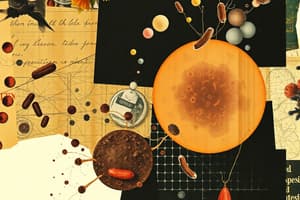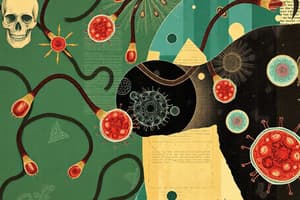Podcast
Questions and Answers
What is the fundamental unit of life?
What is the fundamental unit of life?
- Molecule
- Tissue
- Atom
- Cell (correct)
What is the function of the resolution in microscopy?
What is the function of the resolution in microscopy?
- To adjust light intensity
- To magnify the image
- To distinguish two points on a specimen (correct)
- To visualize cells
What does a light microscope use to magnify the image?
What does a light microscope use to magnify the image?
- Ultraviolet light
- Visible light (correct)
- Magnets
- X-rays
What is the size of most plant and animal cells?
What is the size of most plant and animal cells?
What is the size of the smallest bacteria?
What is the size of the smallest bacteria?
What is the function of contrast in microscopy?
What is the function of contrast in microscopy?
What is the length of some nerve and muscle cells?
What is the length of some nerve and muscle cells?
What is the size of the nucleus?
What is the size of the nucleus?
What is the size of viruses?
What is the size of viruses?
What is the size of ribosomes?
What is the size of ribosomes?
What is the size of small molecules?
What is the size of small molecules?
What is the function of an electron microscope?
What is the function of an electron microscope?
What are the two types of microscopy used to study cells?
What are the two types of microscopy used to study cells?
Where are prokaryotic cells found?
Where are prokaryotic cells found?
What is a basic feature of all cells?
What is a basic feature of all cells?
Where is DNA located in prokaryotic cells?
Where is DNA located in prokaryotic cells?
What is a characteristic of eukaryotic cells?
What is a characteristic of eukaryotic cells?
What do mitochondria produce?
What do mitochondria produce?
What is the process that uses oxygen to break down large molecules into smaller ones?
What is the process that uses oxygen to break down large molecules into smaller ones?
Where is chlorophyll found?
Where is chlorophyll found?
What is the site of photosynthesis in plants and algae?
What is the site of photosynthesis in plants and algae?
What is required for photosynthesis to occur?
What is required for photosynthesis to occur?
What is the function of the nuclear envelope in eukaryotic cells?
What is the function of the nuclear envelope in eukaryotic cells?
What is a characteristic of the inner membrane of mitochondria?
What is a characteristic of the inner membrane of mitochondria?
True or false: The cell is the most complex collection of matter that can live?
True or false: The cell is the most complex collection of matter that can live?
True or false: Scientists use microscopes to visualize cells?
True or false: Scientists use microscopes to visualize cells?
True or false: Resolution is the ratio of an object’s image size to its real size?
True or false: Resolution is the ratio of an object’s image size to its real size?
True or false: Contrast in microscopy refers to the difference in light intensity between the image and the adjacent background?
True or false: Contrast in microscopy refers to the difference in light intensity between the image and the adjacent background?
True or false: The length of some nerve and muscle cells is 10m?
True or false: The length of some nerve and muscle cells is 10m?
True or false: The size of most plant and animal cells is 100µm?
True or false: The size of most plant and animal cells is 100µm?
True or false: The size of the smallest bacteria is 100nm?
True or false: The size of the smallest bacteria is 100nm?
True or false: Viruses are larger than ribosomes?
True or false: Viruses are larger than ribosomes?
True or false: Ribosomes are smaller than mitochondria?
True or false: Ribosomes are smaller than mitochondria?
True or false: The unaided eye can visualize objects as small as atoms?
True or false: The unaided eye can visualize objects as small as atoms?
True or false: The function of the inner membrane of mitochondria is to protect the organelle from damage?
True or false: The function of the inner membrane of mitochondria is to protect the organelle from damage?
True or false: Lipids are larger than small molecules?
True or false: Lipids are larger than small molecules?
Prokaryotic cells lack a nucleus, have DNA in an unbound region called the nucleoid, and lack membrane-bound organelles.
Prokaryotic cells lack a nucleus, have DNA in an unbound region called the nucleoid, and lack membrane-bound organelles.
Eukaryotic cells have internal membranes that partition the cell into organelles.
Eukaryotic cells have internal membranes that partition the cell into organelles.
Mitochondria are sites of cellular respiration to generate ATP, while chloroplasts are sites of photosynthesis found in plants and algae.
Mitochondria are sites of cellular respiration to generate ATP, while chloroplasts are sites of photosynthesis found in plants and algae.
Chloroplasts contain chlorophyll and other molecules for photosynthesis, and their structure includes thylakoids, granum, and stroma.
Chloroplasts contain chlorophyll and other molecules for photosynthesis, and their structure includes thylakoids, granum, and stroma.
Photosynthesis requires light energy, carbon dioxide, and water to produce sugars and oxygen.
Photosynthesis requires light energy, carbon dioxide, and water to produce sugars and oxygen.
Eukaryotic cells are generally smaller than prokaryotic cells.
Eukaryotic cells are generally smaller than prokaryotic cells.
The nuclear envelope in eukaryotic cells does not enclose the nucleus.
The nuclear envelope in eukaryotic cells does not enclose the nucleus.
The inner membrane of mitochondria is smooth and lacks folds.
The inner membrane of mitochondria is smooth and lacks folds.
Aerobic respiration does not require oxygen.
Aerobic respiration does not require oxygen.
Eukaryotic cells lack membrane-bound organelles.
Eukaryotic cells lack membrane-bound organelles.
The plasma membrane is not a basic feature of all cells.
The plasma membrane is not a basic feature of all cells.
Mitochondria do not produce energy.
Mitochondria do not produce energy.
Match the following microscopy terms with their definitions:
Match the following microscopy terms with their definitions:
Match the following cell structures with their sizes:
Match the following cell structures with their sizes:
Match the following cell components with their sizes:
Match the following cell components with their sizes:
Match the following statements with the correct descriptions of cells:
Match the following statements with the correct descriptions of cells:
Match the following cell types with their respective domains:
Match the following cell types with their respective domains:
Match the following cell components with their descriptions:
Match the following cell components with their descriptions:
Match the following cell microscopy with their descriptions:
Match the following cell microscopy with their descriptions:
Match the following cell features with their descriptions:
Match the following cell features with their descriptions:
Match the following cell processes with their descriptions:
Match the following cell processes with their descriptions:
Match the following organelles with their functions:
Match the following organelles with their functions:
Match the following organelle structures with their descriptions:
Match the following organelle structures with their descriptions:
Flashcards are hidden until you start studying
Study Notes
Cell Structure and Function
- There are two types of microscopy used to study cells: Scanning Electron Microscope (SEM) and Transmission Electron Microscope (TEM).
- Prokaryotic and eukaryotic cells are the two types of cells, with prokaryotic cells found in Bacteria and Archaea domains, and eukaryotic cells found in Protists, fungi, animals, and plants.
- Basic features of all cells include plasma membrane, cytosol, chromosomes, and ribosomes.
- Prokaryotic cells lack a nucleus, have DNA in an unbound region called the nucleoid, and lack membrane-bound organelles.
- Eukaryotic cells have DNA in a nucleus bounded by a membranous nuclear envelope, contain membrane-bound organelles, and are generally larger than prokaryotic cells.
- Eukaryotic cells have internal membranes that partition the cell into organelles.
- Organelles in eukaryotic cells have specific functions, such as the nuclear envelope enclosing the nucleus, the nucleolus producing ribosomal RNA, and the mitochondrion producing energy.
- Mitochondria are sites of cellular respiration to generate ATP, while chloroplasts are sites of photosynthesis found in plants and algae.
- Mitochondria have a smooth outer membrane, an inner membrane folded into cristae, and create compartments for energy synthesis.
- Respiration is the process that uses oxygen to break down large molecules into smaller ones, with two types: aerobic (with oxygen) and anaerobic (without oxygen).
- Chloroplasts contain chlorophyll and other molecules for photosynthesis, and their structure includes thylakoids, granum, and stroma.
- Photosynthesis requires light energy, carbon dioxide, and water to produce sugars and oxygen.
Cell Structure and Function
- There are two types of microscopy used to study cells: Scanning Electron Microscope (SEM) and Transmission Electron Microscope (TEM).
- Prokaryotic and eukaryotic cells are the two types of cells, with prokaryotic cells found in Bacteria and Archaea domains, and eukaryotic cells found in Protists, fungi, animals, and plants.
- Basic features of all cells include plasma membrane, cytosol, chromosomes, and ribosomes.
- Prokaryotic cells lack a nucleus, have DNA in an unbound region called the nucleoid, and lack membrane-bound organelles.
- Eukaryotic cells have DNA in a nucleus bounded by a membranous nuclear envelope, contain membrane-bound organelles, and are generally larger than prokaryotic cells.
- Eukaryotic cells have internal membranes that partition the cell into organelles.
- Organelles in eukaryotic cells have specific functions, such as the nuclear envelope enclosing the nucleus, the nucleolus producing ribosomal RNA, and the mitochondrion producing energy.
- Mitochondria are sites of cellular respiration to generate ATP, while chloroplasts are sites of photosynthesis found in plants and algae.
- Mitochondria have a smooth outer membrane, an inner membrane folded into cristae, and create compartments for energy synthesis.
- Respiration is the process that uses oxygen to break down large molecules into smaller ones, with two types: aerobic (with oxygen) and anaerobic (without oxygen).
- Chloroplasts contain chlorophyll and other molecules for photosynthesis, and their structure includes thylakoids, granum, and stroma.
- Photosynthesis requires light energy, carbon dioxide, and water to produce sugars and oxygen.
Cell Structure and Function
- There are two types of microscopy used to study cells: Scanning Electron Microscope (SEM) and Transmission Electron Microscope (TEM).
- Prokaryotic and eukaryotic cells are the two types of cells, with prokaryotic cells found in Bacteria and Archaea domains, and eukaryotic cells found in Protists, fungi, animals, and plants.
- Basic features of all cells include plasma membrane, cytosol, chromosomes, and ribosomes.
- Prokaryotic cells lack a nucleus, have DNA in an unbound region called the nucleoid, and lack membrane-bound organelles.
- Eukaryotic cells have DNA in a nucleus bounded by a membranous nuclear envelope, contain membrane-bound organelles, and are generally larger than prokaryotic cells.
- Eukaryotic cells have internal membranes that partition the cell into organelles.
- Organelles in eukaryotic cells have specific functions, such as the nuclear envelope enclosing the nucleus, the nucleolus producing ribosomal RNA, and the mitochondrion producing energy.
- Mitochondria are sites of cellular respiration to generate ATP, while chloroplasts are sites of photosynthesis found in plants and algae.
- Mitochondria have a smooth outer membrane, an inner membrane folded into cristae, and create compartments for energy synthesis.
- Respiration is the process that uses oxygen to break down large molecules into smaller ones, with two types: aerobic (with oxygen) and anaerobic (without oxygen).
- Chloroplasts contain chlorophyll and other molecules for photosynthesis, and their structure includes thylakoids, granum, and stroma.
- Photosynthesis requires light energy, carbon dioxide, and water to produce sugars and oxygen.
Studying That Suits You
Use AI to generate personalized quizzes and flashcards to suit your learning preferences.




